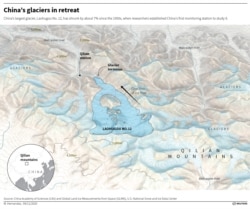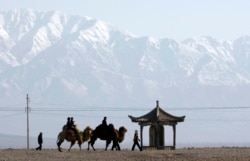Huge fields of ice high in the mountains near Tibet continue to disappear at a rate that worries scientists.
The melting glacier is the largest in the Qilian Mountains, which stretch for 800 kilometers on the dry northeastern edge of the Tibetan Plateau. The glacier has retreated about 450 meters since the 1950s, when researchers set up China’s first observation station to study it.
The 20-square kilometer glacier is known as Laohugou No. 12. Scientists say it has shrunk by about seven percent since measurements began. The rate of melting has increased in recent years, scientists note.
The ice also has lost thickness. About 13 meters of ice has disappeared as temperatures have risen, said Qin Xiang. He is the director at the observation station.
“The speed that this glacier has been shrinking is really shocking,” Qin told Reuters news agency. The scientists work in the station in a frozen, treeless area, where Qin and a small team of researchers measure the changes over time.
The Tibetan plateau is known as the world’s Third Pole because of the amount of ice that is locked in its high-altitude wilderness.
But since the 1950s, average temperatures in the area have risen by about 1.5 degrees Celsius, Qin said. He added that there is no sign of an end to the warming. He is concerned for the 2,684 glaciers in the Qilian Mountains.
China’s Academy of Sciences says that, across the mountains, glacier retreat was 50 percent faster from 1990 to 2010 than it was from 1956 to 1990.
“When I first came here in 2005, the glacier was around that point there where the river bends,” Qin said pointing to the Laohugou Valley where the river runs.
Downstream, near the city of Dunhuang, water flowing out of the mountains has formed a lake in the desert for the first time in 300 years, state media reported.
Dangerous changes
Rising worldwide temperatures are also blamed for changes in the weather that have brought other unpredictable conditions.
Snowfall and rain have at times been much less than normal. The melting glaciers have brought more runoff. But farmers downstream can still face water shortages for their crops of onions and corn and for their animals.
Large parts of the Shule River, outside of Dunhuang, were either dry or reduced to small sections of water, Reuters reported in September.
Liu Junyan is a Greenpeace East Asia climate and energy campaigner. Liu said the melting water brings danger. “Across the region, glacial melt water is pooling into lakes and causing…floods,” Liu said.
The melting on the mountains could peak within 10 years. After that, China Academy of Sciences expert Shen Yongping said, snow melt would sharply decrease because there would be fewer glaciers.
Aaron Putnam is an associate professor of earth sciences at the University of Maine. He said the changes in Qilian are similar to melting in other parts of the Tibetan Plateau. The area is the source of the Yangtze and Yellow Rivers and other great rivers of southeastern Asia such as the Mekong.
I’m Mario Ritter, Jr.
Martin Quin Pollard reported this story for Reuters. Mario Ritter Jr. adapted it for VOA Learning English. Ashley Thompson was the editor.
________________________________________________________________
Words in This Story
glacier –n. a very large area of ice that moves slowly down a slope or valley or over a wide area of land
track –v. to follow or watch the progress of something
altitude –n. the height of something above sea level
peak –v. to reach the highest point of something
We want to hear from you. Write to us in the Comments section, and visit our Facebook page.










